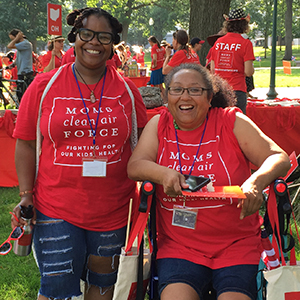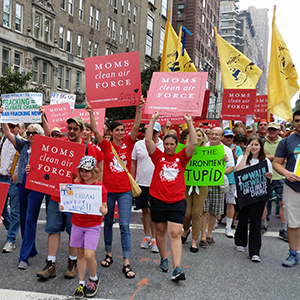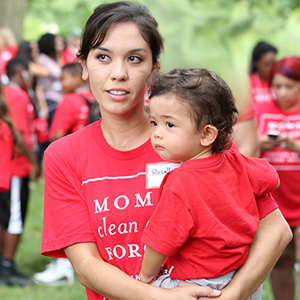By: Elizabeth Brandt, National Field Manager, Moms Clean Air Force
Date: April 12, 2022
About: Control of Air Pollution from New Motor Vehicles: Heavy-Duty Engine and Vehicle Standards Proposed Rule, Docket ID No. EPA-HQ-OAR-2019-0055
To: Environmental Protection Agency
Hello, and thank you for listening to my testimony today. My name is Elizabeth Brandt. I am a social worker and a National Field Manager for Moms Clean Air Force. Moms Clean Air Force is an organization of more than one million parents across America who are taking action against air pollution and climate change.
Thank you for following through on President Biden’s promise to confront pollution from heavy-duty vehicles by proposing this rule. However, the rule’s two proposed options represent, respectively, a bare-minimum floor for regulations and a weak, industry-friendly option that is full of giveaways to the worst-polluting truck companies. EPA must advance the more health-protective option, in accordance with its mission to “protect human health and the environment,” and eliminate loopholes for truck companies. However, this can only be a first step toward greater protection from truck pollution.
These days I live in Maryland, but I’ve lived most of my life in Tacoma and Seattle, Washington. Both cities are major ports with tremendous numbers of trucks traveling through the center of the cities. Our West Seattle home was just over the hill from the Port of Seattle, and I worked at the Office of Indian Child Welfare—less than a half mile from one of the main gates for the Port of Seattle. It is not a coincidence that a state child welfare office primarily dedicated to serving Indigenous families is so close to a major source of truck pollution. Many social service offices are located around truck routes in Seattle and in other cities. Allowing economics and race to push people into pollution hotspots shows how little we regard the health and overall value of some of our fellow Americans.
When I worked at the Office of Indian Child Welfare, I would often take walks with co-workers in an effort to stay fit. Several of us (including me) were pregnant during these years. The air outside the office was manifestly unhealthy. A steel recycling plant is on the next block, and beyond it the backup of trucks waiting to enter the port. The air smells industrial, of diesel and metal, and sometimes I would get a headache after being outside.
I lived over the hill, where the pollution is much less pervasive. Not everyone gets to leave these sources of pollution at the end of the day, though. Many lower income communities in Seattle and Tacoma are directly on the truck routes and I-5, a major trucking corridor. Schools like Maple Elementary are right next to the interstate. The Puyallup Tribal lands are deeply impacted by pollution around the Port of Tacoma, and the Port of Seattle is on unrecognized Duwamish land.
In these neighborhoods, historically unjust pollution seems to be its own rationale for allowing pollution to continue. EPA can show solidarity with the strong Indigenous nations who continue to fight to restore these port areas by enacting the most health-protective truck standards. You can show my colleagues who continue to work at the Office of Indian Child Welfare that you value their health and the health of the people they serve. You can stand up for the health of patients served by the dialysis clinic in that same building.
EPA must enact standards that put the American truck and bus fleet on a clear roadway to 100% zero-emission sales by 2035. Thank you.




